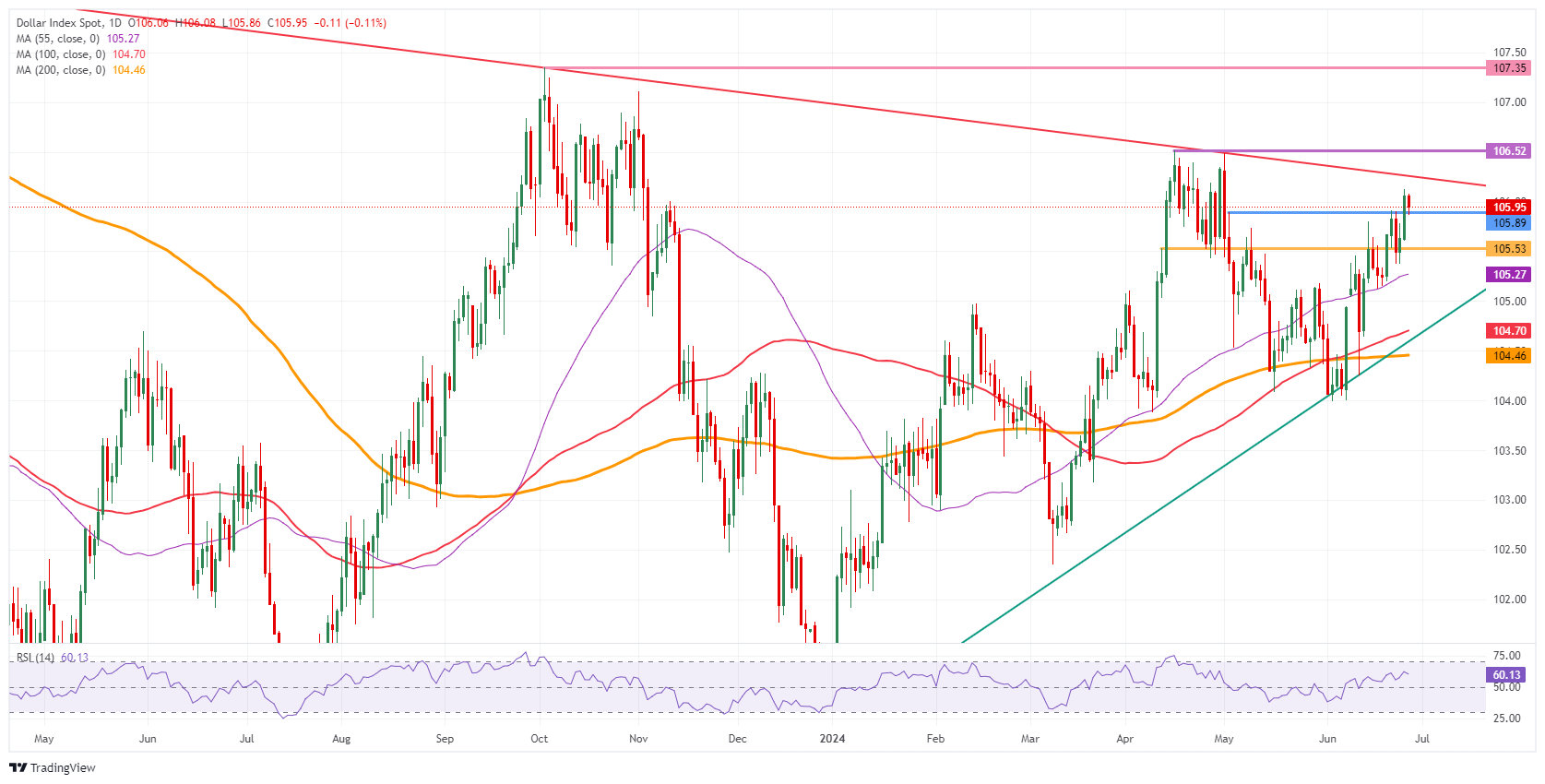- The US Dollar is trading deep down against almost all of its major peers.
- The data set with US GDP, durable goods and weekly jobless claims was not well received by the markets.
- The US Dollar Index bids farewell to 106.00 and heads lower.
He US dollar (USD) falls and in the process is erasing all of last Wednesday’s gains. The large batch of data that was released caused traders to carefully select what elements they would take into their assessment of where to position the US Dollar. Elements such as the increase in continuing orders, the increasing number of wholesale inventories, and the flat decline in durable goods were enough to send the US dollar lower.
On the US economic calendar front, all the data has already been released and markets will now be keeping an eye on the Federal Reserve’s preferred inflation gauge: the Personal Consumption Expenditure Price Index on Friday. If these also decline, as a sign of further disinflation, markets could challenge the Fed’s current hawkish stance with a weaker US dollar. That would mean that in the US Dollar Index, a drop to 105.00 or below could be in the cards.
Daily market movement summary: Consumer signals indicate the end of the road
- At 12:30 GMT, almost all the important data for this Thursday was published:
- US Gross Domestic Product for the third quarter:
- Core GDP grew at an annualized rate of 1.4%, up from the previously estimated 1.3%.
- The GDP Price Index remained stable at 3.1%.
- The headline Personal Consumption Expenditure Price Index rose from 3.3% to 3.4%, while the underlying reading also rose from 3.6% to 3.7%.
- US durable goods for May:
- Core durable goods orders fell to 0.1%, from a revised 0.6% to just 0.2%.
- Durable goods excluding cars and transportation missed estimates and fell from 0.4% to -0.1%.
- Weekly jobless claims for the week ending June 14:
- Initial jobless claims were stronger, from 238,000 to 233,000.
- Continuing claims were an issue, increasing from 1,821,000 to 1,839,000.
- Pending home sales for May declined for the second consecutive week, this time by 2.1%, signaling further trouble for the US housing market.
- US Gross Domestic Product for the third quarter:
- Stocks are trying to reverse this week’s negativity with US stocks rising after the US data on the idea that the Fed’s hawkish stance is a bit overdone.
- The CME Fedwatch tool largely supports a rate cut in September despite recent comments from Fed officials. Odds now stand at 56.3% for a 25 basis point cut. A rate pause has a 37.7% chance, while a 50 basis point rate cut has a slim 6.0% chance.
- The US 10-year Treasury yield is trading near the weekly high at 4.28%.
DXY Dollar Index Technical Analysis: Will PCE Unlock More Weakness?
The US Dollar Index (DXY) has been riding the markets thanks to some external effects. Although the nearby support level at 105.89 appears to be holding for now, expect the mix of data this Thursday and Friday to cause some sharp moves. Rather wait for the dust to settle on Friday afternoon to see where the US Dollar will head once a clear picture has been revealed.
To the upside, the biggest challenge remains 106.52, the year-to-date high since April 16. A rally to 107.35, a level not seen since October 2023, would need to be driven by a surprise rise in US inflation or a more aggressive shift from the Fed.
On the downside, 105.53 is the first support before a trifecta of SMAs. First is the 55-day SMA at 105.27, protecting the round figure at 105.00. A little lower, near 104.70 and 104.46, both the 100-day and 200-day SMA form a double layer of protection to withstand any decline. If this area breaks, 104.00 could save the situation.
Dollar Index: Daily Chart
interest rates
Financial institutions charge interest rates on loans from borrowers and pay them as interest to savers and depositors. They are influenced by basic interest rates, which are set by central banks based on the evolution of the economy. Typically, central banks are mandated to ensure price stability, which in most cases means targeting an underlying inflation rate of around 2%.
If inflation falls below the target, the central bank can cut base interest rates, in order to stimulate credit and boost the economy. If inflation rises substantially above 2%, the central bank typically raises core lending rates to try to reduce inflation.
In general, higher interest rates help strengthen a country’s currency by making it a more attractive place for global investors to park their money.
Higher interest rates influence the price of Gold because they increase the opportunity cost of holding Gold instead of investing in an interest-bearing asset or depositing cash in the bank.
If interest rates are high, the price of the US Dollar (USD) usually rises and, since Gold is priced in dollars, the price of Gold falls.
The federal funds rate is the overnight rate at which U.S. banks lend to each other. It is the official interest rate that the Federal Reserve usually sets at its FOMC meetings. It is set in a range, for example 4.75%-5.00%, although the upper limit (in this case 5.00%) is the figure quoted.
Market expectations about the Federal Reserve funds rate are tracked by the CME’s FedWatch tool, which determines the behavior of many financial markets in anticipation of future Federal Reserve monetary policy decisions.
Source: Fx Street
I am Joshua Winder, a senior-level journalist and editor at World Stock Market. I specialize in covering news related to the stock market and economic trends. With more than 8 years of experience in this field, I have become an expert in financial reporting.








